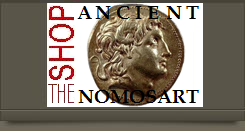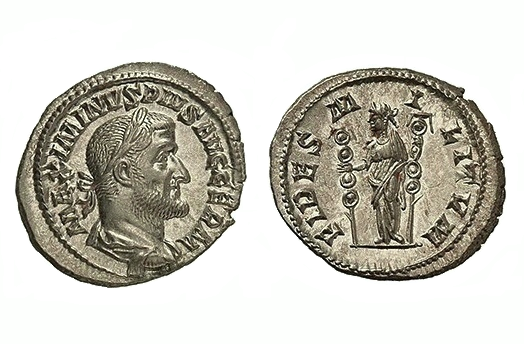
about ancient nomos
Ancient Nomos Art is a museum of galleries exhibiting ancient coins and ancient mint maps. The coin gallery displays the diverse art and history of hand-crafted ancient Greek, Roman, Byzantine, Persian and Medieval coinage. The ancient mints mapping gallery features Greek, Roman, Byzantine, Asia Minor and Medieval mint city regions and territories. Visitor's are welcome to explore, study and enjoy Ancient Nomos Art.

Imperial, Roman – 236 AD
Maximinus I
From Ancient Galleries

Obverse: Laureate, cuirassed and draped bust of Maximinus I (the Senior) as Augustus.
Reverse: Goddess Fides standing facing with head turned left, holding Roman military Signum.
LEGEND
Obv: Obv: MAXIMINVS PIVS AVG GERM, Laureate, cuirassed and draped bust of Maximinus I (the Senior) as Augustus facing right. Rev: FIDES MILITVM, Goddess Fides standing facing with head turned left, holding Roman military signum, one in each hand.
This exceptional Maximinus I Thrax denarius depicts the mighty presence of this first-to-rule, barbarian born, Roman emperor. Named Gaius Iulius Verus Maximinus (c. 173-235 AD), also known as Maximinus I Thrax (the Thracian). Maximinus is best known as being the first barbarian-born individual to become an emperor of the Roman Empire. He was also the first of what was to later become a long line of military leaders to wear the imperial purple. Maximinus was born in Thrace to a Gothic father and apparently an Alanic mother in 173 AD. He is perhaps best described as being the largest of Roman emperors, allegedly thought to have been 2.59 meters tall, with large physical attributes and great strength. His rise to power began after joining the army under the reign of Septimius Severus, but he did not gain prominence until his promotions under Emperor Alexander Severus. While Maximinus was in command of his army recruits from Pannonia, his legions of soldiers became angered by the so-called timid nature of Alexander’s approach to war. In addition, the troops were perturbed by the payments Alexander was giving to the Alemanni. His soldier soon took it upon themselves to murder Alexander, along with his family, while they were visiting Moguntiacum. The army then declared Maximinus the new emperor of Rome. Maximinus was immediately at odds with the Roman Senate from the very start of his reign. He was always suspicious of the Roman nobles and elite classes, as was in turn the Senate and Praetorian Guard displease to have a lower class peasant as the new imperial leader of Rome. The angry differences among the classes eventually lead to the downfall of Maximinus, within just two short years of his reign. Within a year all out revolts in Africa lead to major uprisings in the Tunisian provinces. The uprisings forced the landowners to put their support behind the provincial governor, Gordianus Sempronianus and son Gordian II, in 238 AD. The Roman Senate also endorsed the landowner’s declaration and formally pronounced the two Gordian’s co-emperors, with Gordian I receiving the title “Augustus” Imperator. Intrigue soon followed, as Maximinus began marching his army toward Rome, while Gordian began advancing his army toward Carthage. The Carthagian army easily overwhelmed the Gordian militia and killed Gordian II. Gordian senior was defeated and quickly hanged himself. After these disastrous events, the Senate was still determined to overthrow Maximinus I and quickly elected two senate members, Pupienus and Balbinus, as new co-emperors. Meanwhile, the march onto Rome by Maximinus found itself short on supplies and food in Aquileia. Soon famine and disease began to spread through the ranks. Finally, his very own Praetorian Guard soldiers turn on Maximinus and assassinated the emperor, his son, and ministers, in the spring of 238 AD.
Special note: Some have suggested that the Roman portrait realism of this early reign specimen, depicting the mature Maximinus I Thrax with his unique and heavy facial features, including; a prominent suborbital ridge, very large nose, protruding lower chin and jaw bone, clinically suggests he perhaps suffered from the pituitary disorder known as acromegaly. H. L. Klawans, Historical Aspects of the Neurosciences, 1982, pages 317-326.
DOCUMENTATION
Value: Denarius. Metal: AR Silver. Weight: 3.21 grams. Mint: Rome, 2nd officina. Date: Late 236 AD, 4th-6th emission.
Attribution: Roman Imperial Coinage IV 18a; BMC 137; MIR 27, 21-3; RSC 9.
Legend, Documentation and Attribution
